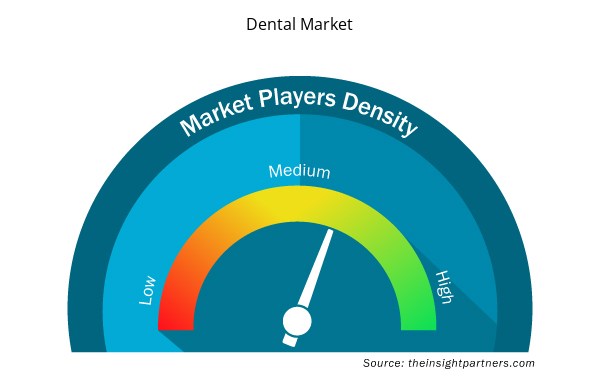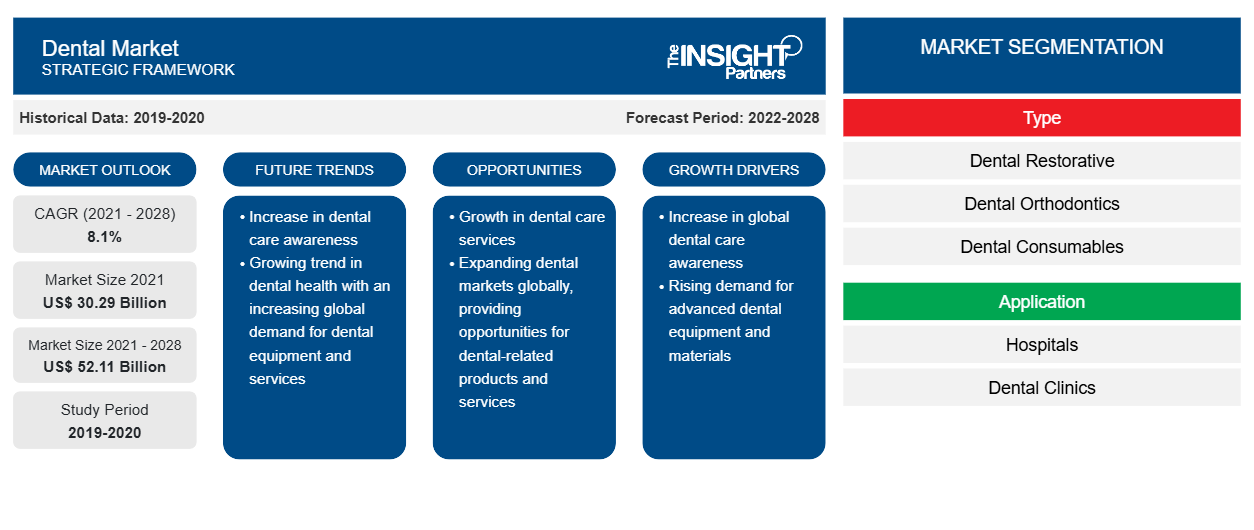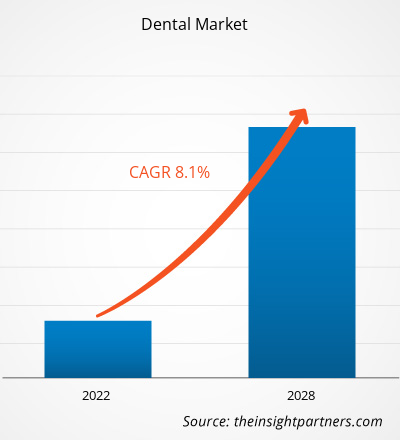Der Dentalmarkt soll von 30.287,91 Millionen US-Dollar im Jahr 2021 auf 52.105,14 Millionen US-Dollar im Jahr 2028 wachsen; von 2021 bis 2028 wird mit einer durchschnittlichen jährlichen Wachstumsrate von 8,1 % gerechnet.
Die steigende Zahl von Zahnerkrankungen, die steigende Nachfrage nach kosmetischen Zahnbehandlungen, die zunehmende Zahl von Zahnfehlstellungen bei Kindern und technologische Entwicklungen dürften das globale Marktwachstum ankurbeln. Die begrenzte Erstattung von Dentalprodukten hemmt jedoch das Marktwachstum. Der Bericht hebt die Schlüsselfaktoren hervor, die das Marktwachstum vorantreiben, sowie prominente Akteure mit ihren Entwicklungen auf dem Markt. Die USA werden voraussichtlich der größte und am schnellsten wachsende Markt für Dentalprodukte in Nordamerika sein. In den USA gibt es große Unterschiede in der Zahngesundheit. Trotz erheblicher Verbesserungen der Zahngesundheit der Bevölkerung bestehen für viele Rassen und ethnische Gruppen Unterschiede in Bezug auf sozioökonomischen Status, Geschlecht, Alter und geografische Lage. Zahnerkrankungen sind eine der am besten vermeidbaren Herausforderungen für die öffentliche Gesundheit unter den chronischen Erkrankungen in den USA. Die Mundpflege wird im Land immer fortschrittlicher und intelligenter. Darüber hinaus leiden etwa 47,2 % der Erwachsenen in den USA an einer Art von Parodontitis. Bei Erwachsenen im Alter von 65 Jahren und älter leiden 70,1 % an Parodontitis. Die hohe Prävalenz von Zahnerkrankungen wird voraussichtlich das Wachstum des Marktes für Zahnimplantate in den USA vorantreiben. In Deutschland gibt es immer mehr Unternehmen, die Zahnrestaurationen und Implantate herstellen. Verschiedene im ganzen Land tätige globale Unternehmen haben ihr Produktangebot erweitert. Ebenso sind lokale Unternehmen an der Entwicklung restaurativer Produkte beteiligt. Im März 2017 kündigte die Natural Dental Implants AG die Einführung einer 3D-gedruckten Version des REPLICATE Tooth an. Daher wird erwartet, dass die Entwicklungen in der Dentalbranche das Marktwachstum im Prognosezeitraum unterstützen werden.
Passen Sie diesen Bericht Ihren Anforderungen an
Sie erhalten kostenlose Anpassungen an jedem Bericht, einschließlich Teilen dieses Berichts oder einer Analyse auf Länderebene, eines Excel-Datenpakets sowie tolle Angebote und Rabatte für Start-ups und Universitäten.
- Holen Sie sich die wichtigsten Markttrends aus diesem Bericht.Dieses KOSTENLOSE Beispiel umfasst eine Datenanalyse von Markttrends bis hin zu Schätzungen und Prognosen.
Dental bezieht sich auf die Mundgesundheit einer Person, die Zähne, Zahnfleisch und Mund umfasst. Zahlreiche Krankheiten und Störungen können die Zahngesundheit einer Person beeinträchtigen. Wenn Sie Ihre Mundgesundheit nicht richtig pflegen, kann dies zu weiteren gesundheitlichen Problemen führen. Dentalprodukte werden zur Behandlung von Zahnproblemen und -störungen verwendet.
Markteinblicke
Blühender Medizintourismus in Entwicklungsländern
Der Medizintourismus, bei dem man ins Ausland reist, um zu wesentlich geringeren Kosten medizinische Leistungen zu erhalten, hat in den letzten Jahren bei Zahnimplantatbehandlungen erheblich an Popularität gewonnen. Die meisten Anzeigen für den Zahntourismus richten sich an amerikanische Bürger für eine Behandlung in Mexiko oder Costa Rica und an Australier für eine Behandlung in Thailand oder Indien. Der Zahntourismus ist ein zunehmend wichtiger Teil des Medizintourismusmarktes.
Der Zahnimplantat-Tourismus in Indien floriert aufgrund der hohen Qualität der durchgeführten Arbeiten zu niedrigeren Preisen als in anderen Ländern. Ebenso nimmt der Zahntourismus in asiatischen Ländern wie Indien, Südkorea und Thailand zu. Laut dem Journal of Clinical and Diagnostic Research 2016 betragen die Kosten für ein Lächelndesign in den USA ca. 8.000 US-Dollar und in Indien ca. 1.000 US-Dollar. Auch Singapur bietet medizinische und zahnärztliche Dienstleistungen zu erschwinglichen Preisen an. Viele Patienten reisen aus nahegelegenen Ländern wie Malaysia und Indonesien an, und Industrieländer wie die USA und Großbritannien entscheiden sich für Singapur. Der wachsende Patientenstamm in den Schwellenländern für eine zahnärztliche Behandlung wird dem Dentalmarkt in diesen Regionen wahrscheinlich Wachstumschancen bieten.
Typbasierte Erkenntnisse
Der Dentalmarkt ist nach Typ in Zahnrestauration , Zahnkieferorthopädie, Dentalverbrauchsmaterialien und andere Spezialgebiete unterteilt. Das Segment Dentalverbrauchsmaterialien hatte im Jahr 2021 den größten Marktanteil.
Die Marktteilnehmer verfolgen organische Strategien wie Produkteinführung und -erweiterung, um ihre Präsenz und ihr Produktportfolio weltweit zu erweitern und die wachsende Nachfrage zu befriedigen. Die Entwicklungen der Unternehmen auf dem Dentalmarkt wurden als organische und anorganische Entwicklungen charakterisiert. Verschiedene Unternehmen konzentrieren sich auf organische Strategien wie Produkteinführung und -erweiterung. Anorganische Wachstumsstrategien, die auf dem Dentalmarkt zu beobachten waren, waren Partnerschaften und Kooperationen. Diese Wachstumsstrategien haben den Akteuren auf dem Dentalmarkt bei der Expansion ihrer Geschäfte geholfen und ihre geografische Präsenz erweitert. Darüber hinaus halfen Wachstumsstrategien wie Übernahmen und Partnerschaften dabei, ihren Kundenstamm zu stärken und das Produktportfolio zu erweitern. Die Unternehmen haben ihr Wachstum mit mehreren anorganischen Strategien maximiert, um den Wert und die Position des Dentalmarkts auf dem Markt zu steigern. Organische Entwicklungen machen 46,67 % der gesamten strategischen Entwicklungen auf dem Dentalmarkt aus. Anorganische Strategien hingegen machen 53,33 % des Wachstums der Unternehmen aus.
Der Dentalmarkt wurde wie folgt segmentiert:
Der Dentalmarkt ist nach Typ und Anwendung unterteilt. Nach Typ ist der Dentalmarkt in Zahnrestauration, Zahnkieferorthopädie, Dentalverbrauchsmaterialien und andere Spezialgebiete unterteilt. Das Segment Dentalverbrauchsmaterialien hatte 2021 den größten Marktanteil. Der Dentalmarkt ist nach Anwendung in Krankenhäuser, Zahnkliniken und andere unterteilt. Das Segment Krankenhäuser hatte 2021 den größten Marktanteil; das Segment Zahnkliniken dürfte jedoch im Prognosezeitraum die höchste durchschnittliche jährliche Wachstumsrate verzeichnen.
Regionale Einblicke in den Dentalmarkt
Die regionalen Trends und Faktoren, die den Dentalmarkt im Prognosezeitraum beeinflussen, wurden von den Analysten von Insight Partners ausführlich erläutert. In diesem Abschnitt werden auch die Dentalmarktsegmente und die Geografie in Nordamerika, Europa, im asiatisch-pazifischen Raum, im Nahen Osten und Afrika sowie in Süd- und Mittelamerika erörtert.

- Holen Sie sich regionale Daten zum Dentalmarkt
Umfang des Dentalmarktberichts
| Berichtsattribut | Details |
|---|---|
| Marktgröße im Jahr 2021 | 30,29 Milliarden US-Dollar |
| Marktgröße bis 2028 | 52,11 Milliarden US-Dollar |
| Globale CAGR (2021 - 2028) | 8,1 % |
| Historische Daten | 2019-2020 |
| Prognosezeitraum | 2022–2028 |
| Abgedeckte Segmente | Nach Typ
|
| Abgedeckte Regionen und Länder | Nordamerika
|
| Marktführer und wichtige Unternehmensprofile |
|
Dichte der Akteure auf dem Dentalmarkt: Die Auswirkungen auf die Geschäftsdynamik verstehen
Der Dentalmarkt wächst rasant, angetrieben durch die steigende Nachfrage der Endverbraucher aufgrund von Faktoren wie sich entwickelnden Verbraucherpräferenzen, technologischen Fortschritten und einem größeren Bewusstsein für die Vorteile des Produkts. Mit steigender Nachfrage erweitern Unternehmen ihr Angebot, entwickeln Innovationen, um die Bedürfnisse der Verbraucher zu erfüllen, und nutzen neue Trends, was das Marktwachstum weiter ankurbelt.
Die Marktteilnehmerdichte bezieht sich auf die Verteilung der Firmen oder Unternehmen, die in einem bestimmten Markt oder einer bestimmten Branche tätig sind. Sie gibt an, wie viele Wettbewerber (Marktteilnehmer) in einem bestimmten Marktraum im Verhältnis zu seiner Größe oder seinem gesamten Marktwert präsent sind.
Die wichtigsten auf dem Dentalmarkt tätigen Unternehmen sind:
- Dentsply Sirona
- Danaher
- Technologien ausrichten
- Ivoclar Vivadent AG
- 3M
Haftungsausschluss : Die oben aufgeführten Unternehmen sind nicht in einer bestimmten Reihenfolge aufgeführt.

- Überblick über die wichtigsten Akteure auf dem Dentalmarkt
Firmenprofile
- Dentsply Sirona
- Danaher
- Technologien ausrichten
- Ivoclar Vivadent AG
- 3M
- Dentallabor
- Zimmer Biomet
- Ultradent Products Inc.
- Planmeca OY
- Shofu Global
- Historische Analyse (2 Jahre), Basisjahr, Prognose (7 Jahre) mit CAGR
- PEST- und SWOT-Analyse
- Marktgröße Wert/Volumen – Global, Regional, Land
- Branche und Wettbewerbsumfeld
- Excel-Datensatz



Report Coverage
Revenue forecast, Company Analysis, Industry landscape, Growth factors, and Trends

Segment Covered
This text is related
to segments covered.

Regional Scope
North America, Europe, Asia Pacific, Middle East & Africa, South & Central America

Country Scope
This text is related
to country scope.
Häufig gestellte Fragen
The dental consumables segment held the largest revenue share in 2021.
Dental is a termed used for the oral health concerned with teethe, gums and mouth of an individual. Considering the fact that other disease and different conditions can affect the dental health of a person, failing to properly care for your oral health may lead to other severe health issues. The dental products are used to treatment of dental problems and diseases.
As per application, the dental clinic segment is accounted to grow at the fastest CAGR in the market during the forecast period.
The dental market majorly consists of the players such as Dentsply Sirona; Danaher; Align Technologies; Ivoclar Vivadent AG; 3M; Carestream Dental LLC.; Zimmer Biomet; Ultradent Products Inc.; Planmeca OY; and Shofu Global among others.
Trends and growth analysis reports related to Life Sciences : READ MORE..
The List of Companies - Dental Market
- Dentsply Sirona
- Danaher
- Align Technologies
- Ivoclar Vivadent AG
- 3M
- Carestream Dental LLC.
- Zimmer Biomet
- Ultradent Products Inc.
- Planmeca OY
- Shofu Global
The Insight Partners performs research in 4 major stages: Data Collection & Secondary Research, Primary Research, Data Analysis and Data Triangulation & Final Review.
- Data Collection and Secondary Research:
As a market research and consulting firm operating from a decade, we have published and advised several client across the globe. First step for any study will start with an assessment of currently available data and insights from existing reports. Further, historical and current market information is collected from Investor Presentations, Annual Reports, SEC Filings, etc., and other information related to company’s performance and market positioning are gathered from Paid Databases (Factiva, Hoovers, and Reuters) and various other publications available in public domain.
Several associations trade associates, technical forums, institutes, societies and organization are accessed to gain technical as well as market related insights through their publications such as research papers, blogs and press releases related to the studies are referred to get cues about the market. Further, white papers, journals, magazines, and other news articles published in last 3 years are scrutinized and analyzed to understand the current market trends.
- Primary Research:
The primarily interview analysis comprise of data obtained from industry participants interview and answers to survey questions gathered by in-house primary team.
For primary research, interviews are conducted with industry experts/CEOs/Marketing Managers/VPs/Subject Matter Experts from both demand and supply side to get a 360-degree view of the market. The primary team conducts several interviews based on the complexity of the markets to understand the various market trends and dynamics which makes research more credible and precise.
A typical research interview fulfils the following functions:
- Provides first-hand information on the market size, market trends, growth trends, competitive landscape, and outlook
- Validates and strengthens in-house secondary research findings
- Develops the analysis team’s expertise and market understanding
Primary research involves email interactions and telephone interviews for each market, category, segment, and sub-segment across geographies. The participants who typically take part in such a process include, but are not limited to:
- Industry participants: VPs, business development managers, market intelligence managers and national sales managers
- Outside experts: Valuation experts, research analysts and key opinion leaders specializing in the electronics and semiconductor industry.
Below is the breakup of our primary respondents by company, designation, and region:

Once we receive the confirmation from primary research sources or primary respondents, we finalize the base year market estimation and forecast the data as per the macroeconomic and microeconomic factors assessed during data collection.
- Data Analysis:
Once data is validated through both secondary as well as primary respondents, we finalize the market estimations by hypothesis formulation and factor analysis at regional and country level.
- Macro-Economic Factor Analysis:
We analyse macroeconomic indicators such the gross domestic product (GDP), increase in the demand for goods and services across industries, technological advancement, regional economic growth, governmental policies, the influence of COVID-19, PEST analysis, and other aspects. This analysis aids in setting benchmarks for various nations/regions and approximating market splits. Additionally, the general trend of the aforementioned components aid in determining the market's development possibilities.
- Country Level Data:
Various factors that are especially aligned to the country are taken into account to determine the market size for a certain area and country, including the presence of vendors, such as headquarters and offices, the country's GDP, demand patterns, and industry growth. To comprehend the market dynamics for the nation, a number of growth variables, inhibitors, application areas, and current market trends are researched. The aforementioned elements aid in determining the country's overall market's growth potential.
- Company Profile:
The “Table of Contents” is formulated by listing and analyzing more than 25 - 30 companies operating in the market ecosystem across geographies. However, we profile only 10 companies as a standard practice in our syndicate reports. These 10 companies comprise leading, emerging, and regional players. Nonetheless, our analysis is not restricted to the 10 listed companies, we also analyze other companies present in the market to develop a holistic view and understand the prevailing trends. The “Company Profiles” section in the report covers key facts, business description, products & services, financial information, SWOT analysis, and key developments. The financial information presented is extracted from the annual reports and official documents of the publicly listed companies. Upon collecting the information for the sections of respective companies, we verify them via various primary sources and then compile the data in respective company profiles. The company level information helps us in deriving the base number as well as in forecasting the market size.
- Developing Base Number:
Aggregation of sales statistics (2020-2022) and macro-economic factor, and other secondary and primary research insights are utilized to arrive at base number and related market shares for 2022. The data gaps are identified in this step and relevant market data is analyzed, collected from paid primary interviews or databases. On finalizing the base year market size, forecasts are developed on the basis of macro-economic, industry and market growth factors and company level analysis.
- Data Triangulation and Final Review:
The market findings and base year market size calculations are validated from supply as well as demand side. Demand side validations are based on macro-economic factor analysis and benchmarks for respective regions and countries. In case of supply side validations, revenues of major companies are estimated (in case not available) based on industry benchmark, approximate number of employees, product portfolio, and primary interviews revenues are gathered. Further revenue from target product/service segment is assessed to avoid overshooting of market statistics. In case of heavy deviations between supply and demand side values, all thes steps are repeated to achieve synchronization.
We follow an iterative model, wherein we share our research findings with Subject Matter Experts (SME’s) and Key Opinion Leaders (KOLs) until consensus view of the market is not formulated – this model negates any drastic deviation in the opinions of experts. Only validated and universally acceptable research findings are quoted in our reports.
We have important check points that we use to validate our research findings – which we call – data triangulation, where we validate the information, we generate from secondary sources with primary interviews and then we re-validate with our internal data bases and Subject matter experts. This comprehensive model enables us to deliver high quality, reliable data in shortest possible time.


 Holen Sie sich ein kostenloses Muster für diesen Bericht
Holen Sie sich ein kostenloses Muster für diesen Bericht